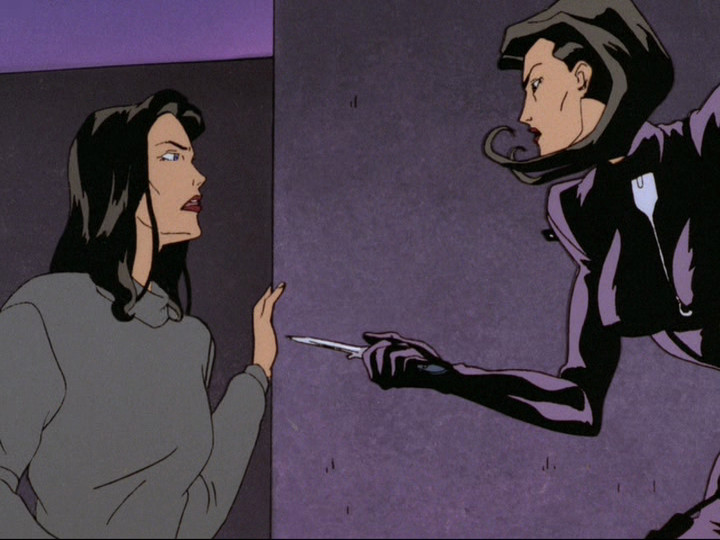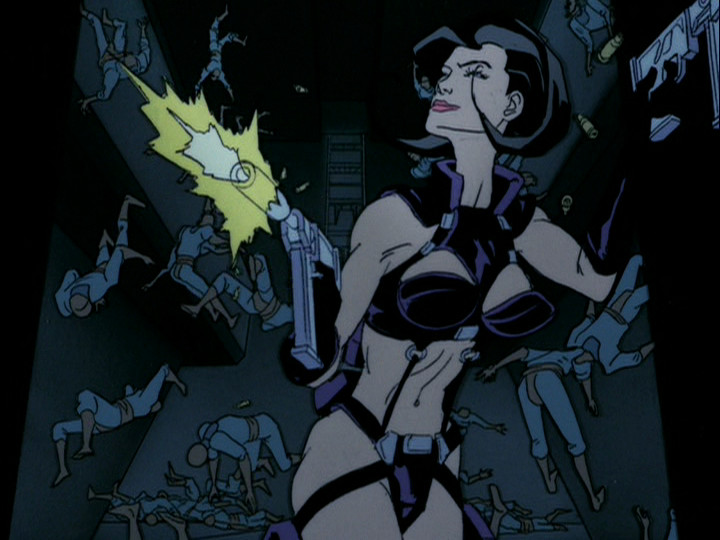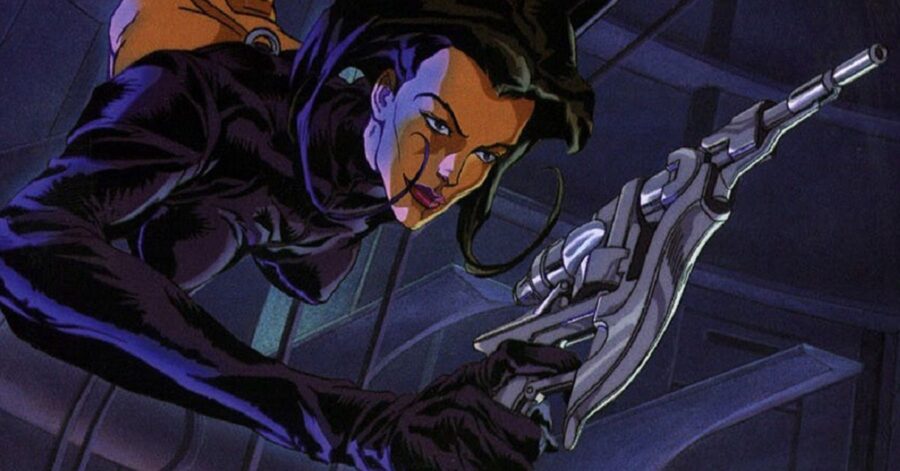My reaction to a second season of Netflix’s animated anthology series Love, Death & Robots was preemptive exhaustion. I enjoyed some of the first wave of episodes, especially Albert Mielgo’s “The Witness” and Robert Valley’s “Zima Blue,” but the sales pitch of animation for “mature, messed-up” adults made me cringe. For a series that claims maturity, the majority of season 1’s otherwise beautifully animated shorts felt like exercises in adolescent hyper-fixation, with only blood, boobs, and gore as a thematic through-line. There was nothing beneath their shiny surfaces.
Luckily, Love, Death & Robots season 2 improves upon the first, with eight shorts that cut down on the gratuitous nudity and violence and are speculative in a way that’s actually mature. Adapting works by J.G. Ballard and Harlan Ellison, and the addition of Jennifer Yuh Nelson (Kung Fu Panda 2), who joins series creator Tim Miller (Deadpool) as co-executive producer and directs “Pop Squad,” one of this season’s standout installments, all seems to have helped the series to grow.
But there’s still the issue of classifying Love, Death & Robots as “adult” animation, a description that, however well meaning, inadvertently frames the medium as one intended “for kids.” How then do we even go about defining “adult” animation, let alone good “adult” animation? My definition comes from one particular series: Peter’s Chung’s avant-garde sci-fi series Æon Flux. More contemporary incarnations of the genre (including Love, Death,& Robots) could learn from the precedent that creator Peter Chung and his team set nearly 30 years ago.

Image: MTV Animation
Premiering on MTV’s experimental animation variety show Liquid Television in 1991, Æon Flux follows a dominatrix-assassin as she shoots her way through winding corridors of a vast and seemingly impregnable complex while on an unspecified mission. At first glance, the first two-minute segment appears to perpetuate the same tired conventions of so-called “adult” animation of which I would accuse the first season of Love, Death & Robots: an overreliance on surface-level violence and scantily clad sexual imagery in service of the male gaze. Even the thunderous orchestral score was, according to series composer Drew Neumann, explicitly designed to deceive the audience by invoking John Williams’ Raiders of the Lost Ark theme … but “broken.”
Æon Flux’s second segment completely reverses the dynamics. Acting as a grisly counterpoint to the action movie heroics of the first, Chung frames the episode from the vantage point of one of Aeon’s innumerable and anonymous adversaries, opening with a dying man experiencing a Steambot Willie-esque hallucination as he succumbs to his wounds. Surrounding him are other bodies, too many to count, lying in a massive pool of blood and heaped into dozens of mountains of corpses. A group of custodians with mops looks on from the sidelines as Aeon marches forward, shooting off-screen with reckless abandon. It turns out, our heroine might not in fact be a heroine at all. What exactly is Aeon aiming to accomplish here? What did these soldiers do to provoke such an attack? Who exactly are the “good” guys and who are the “bad” guys in this situation?
Everything about Æon Flux revolves around subverting expectations and inspiring the viewer to scrutinize beyond the surface of a first impression. Initially pitched as a Spy vs. Spy-like action series, and combining such far-flung points of inspiration as Franco-Belgian comics, cyberpunk fiction, and Gnosticism, the original 12-minute pilot and its five-episode second season are nearly absent of spoken dialogue. Instead, the animator speaks to the audience through designed environments, dynamic camera angles, and elaborate, expressive actions and gestures. “My stories have ambiguity, so I don’t want them to be ambiguous portrayals of an ambiguous event,” Chung said in an interview with Art of the Title back in 2017. “I want them to be as clear a portrayal of an ambiguous event as possible.”

Image: MTV Animation
This emphasis on artful ambiguity and rhetorical sleight-of-hand remained when Chung made the leap to fully voiced characters and storylines with a final season of half-hour episodes. To maintain the spirit of the show with a newly voiced, and occasionally quite verbose incarnation of Aeon, Æon Flux relied on double, sometimes even triple entendres. Speech was, in the words of voice director Jack Fletcher on the DVD commentary track for the Season 3 episode “Utopia or Deuteranopia?,” “‘[…] a kind of italicized or an underlying way of saying what they were saying with their facial gestures.” Dialogue, then, became a complementary element to the mystery and appeal inherent in each episode. Aeon dies at some point or another in every short, effectively resetting the continuity of its universe and characters, and with it, the viewer’s understanding of that universe, forcing the audience to scrutinize the subtleties of its characters’ interactions in order to discern the greater meaning of the whole from its parts. The very design of Aeon herself feels like an implicit critique of the aestheticization of violence; an attractive, yet grotesque imaging of lethal femininity transmogrified through the power of the male gaze.
The writing in Æon Flux is a balancing act between giddy throwbacks to action and sci-fi serials, while deliberately prompting the audience to question the arbitrary moral justifications for the violence for which they’re witnessing. Nowhere is this more apparent than in the second season short, succinctly titled “War,” which follows two opposing factions locked in a brutal and uncompromising battle. The short opens on Aeon, who is promptly killed along with one of her allies. Then Chung switches to the perspective of her killer, who himself is killed by a sword-wielding martial artist, and so on, with no spoken dialogue whatsoever. “War” foregrounds the arbitrariness of right and wrong, revealing through nuanced beats and animation the personality and drives of each protagonist in less than five minutes. The impetus and goal of the battle itself is never shown nor even implied; war exists as an example of supposedly “mindless” action spectacle that explicates the human dimension and mortal loss of those who participate in it. Æon Flux speaks to its audience not by excoriating the pleasure of watching a ton of dudes getting gunned down by mortar fire and machine guns, but making the thematic interrogation of that pleasure a central part of the experience.
Thanks to a biopunk, star-crossed romance set between the fault lines of a never-ending conflict between an Orwellian nation of technocrats and an anarchistic city-state of libertine saboteurs, Chung had the freedom in Æon Flux to dabble in every kind of genre and mythology. The half-hour episode titled “The Demiurge” asks big questions with open-ended answers, with a premise which the animator describes in the DVD director’s commentary as the ultimate Aeon Flux mission. In the episode, Aeon is on a mission to kill God, literally. At the crux of the episode is a philosophical struggle between two characters: Aeon herself and Trevor Goodchild, her nemesis-lover and the leader of Bregna. Although her mission is presumably just another battle in the ongoing feud between the two nations, Aeon’s quest to kill the Demiurge is a personal one. “Because of the possibility of the existence of a deity, one that has a perfect moral authority, the existence of that makes Aeon uncomfortable,” says Chung. “She’s not prepared to deal with the guilt of what she does with her life, which is leading a life of violence.”

Image: MTV Animation
Meanwhile, Trevor’s desire to manifest the Demiurge into the material world is motivated by his own selfish desire to maintain complete control over Bregna and assume even more power, while at the same time freeing himself from the burden of responsibility inherent to his role as the country’s dictator and his conquest to obtain more power. The episode leaves it to the audience to interpret whether the motivations of either character are justifiable or not, implicating them in the larger existential and theological argument at the story’s heart.
The half-hour episode “A Last Time For Everything” stands out as one of the series’ most affecting and memorable. In the episode, we see the complicated romantic dynamic between Aeon and Trevor on full display when the latter surreptitiously clones the former, only for the original Aeon and her clone to switch places in a plot to emotionally destroy him. It’s only later that the audience learns the truth: that Aeon does in fact love Trevor, despite herself, and that Trevor’s ploy presented her with the perfect opportunity to pursue a life with him without compromising her individualistic drive for freedom and havoc. When we see Aeon confronting her clone during the episode’s climax, we’re watching a character confront a truth about herself that she would otherwise never fully admit were she not talking to herself, and even then, a copy whose own motivations and feelings have begun to diverge from hers. To admit her love for Trevor would be to relinquish an aspect of herself just as essential and undeniable as that love, one which would ultimately represent the “death” of Aeon as both we the audience and herself “know” her to be.
The ambiguity of Æon Flux’s characters and universe, along with its distinctive art style, are essential to its enduring legacy as a touchstone of artful adult animation. It’s a series that, despite its surface appearance, is one of the few non-comedy adult animated shows that both relished in the surface level gratifications of sex and violence while simultaneously provoking the audience to interrogate those very gratifications. Æon Flux is a series that, in its own way, respected its audience enough to treat them like adults. When Love, Death, and Robots learns to do the same, the series will be all the better for it.
Æon Flux is available to stream on Paramount Plus and MTV.com
Polygon – All
Source link
Related Post:
- Cryptozoo review: Dash Shaw’s animated adventure is strictly for adults
- US: Edible offering selection of Mario Kart 8 Deluxe treats and Switch giveaways
- Guilty Gear Strive Second DLC Character Jack-O’ Tricks and Treats Later This Month
- Adult Swim’s Uzumaki miniseries gets new release date and a sneak peek
- Riot Games taps a new audience on mobile
- Valve Responds To ‘Switch Vs Steam Deck’ Comparisons, Insists It’s “Going After” A Different Audience
- Life Is Strange: True Colors Twitch Extension Lets The Audience Decide The Adventure
- Ex-Aeon Must Die devs criticise game’s re-emergence following “abuse, manipulation, theft” allegations • Eurogamer.net
- Former Aeon Must Die developers claim legal dispute unresolved, but publisher says accusations were unconfirmed
- Aeon Drive Demo Is Now Available For Xbox One And Xbox Series X|S
